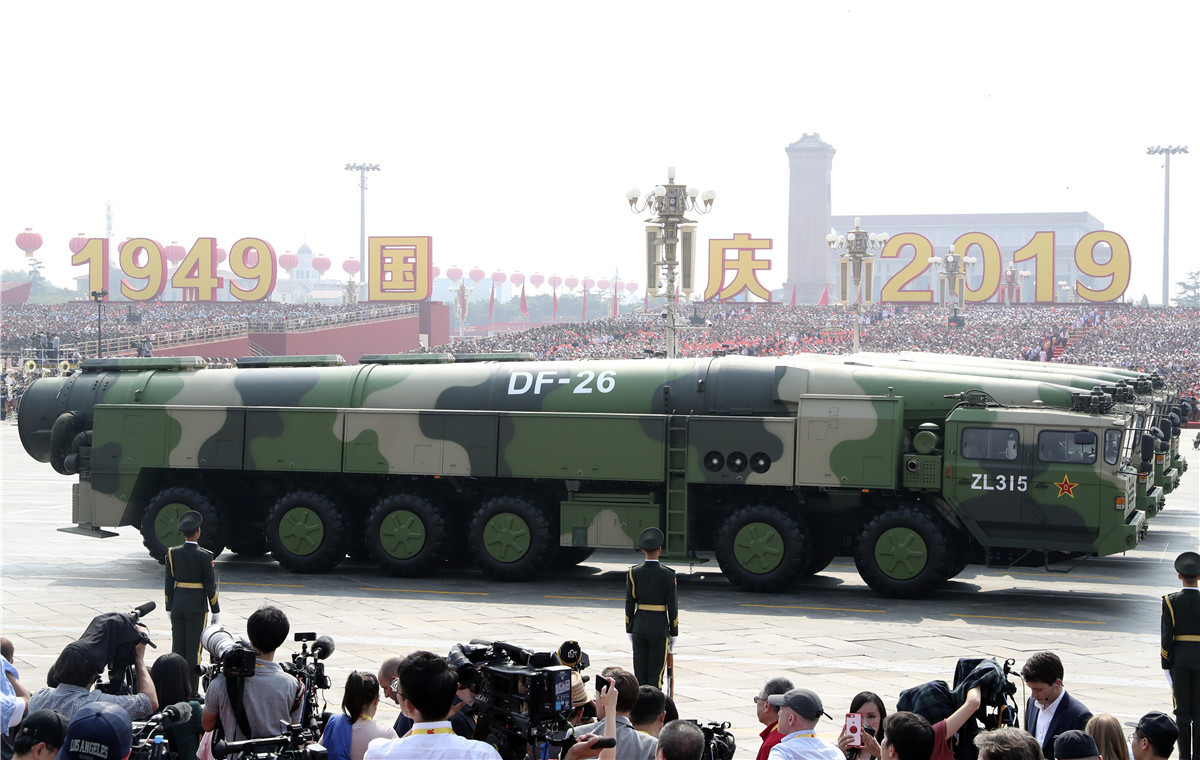China will debut the DF-26D, an enhanced variant of the deadly ‘Guam Killer’ ballistic missile, in the upcoming Victory Day Parade that will take place at Tiananmen Square on September 3 at 9:00 am local time.
The event, considered the largest in years, will feature the debut of some of China’s most sophisticated weapon systems.
China is hosting the event for the first time to mark the 80th anniversary of the victory in the Chinese People’s War of Resistance Against Japanese Aggression and the World Anti-Fascist War.
The parade will be attended by Russian President Vladimir Putin, North Korean leader Kim Jong-un, and Iranian President Hassan Rouhani—leaders of states seen as adversaries by the United States.
The parade is being perceived as a display of Beijing’s military might and diplomatic prowess amid tensions with the US, as China is set to debut advanced weapon systems developed as part of a sustained military modernisation taking place in the country.
Chinese state media reported that a host of land, sea, and air-based strategic weapons, hypersonic precision strike weapons, and unmanned and counter-unmanned equipment are set to be displayed to the outside world for the first time. More than 100 different types of equipment will be displayed during the procession, as per the Chinese state broadcaster CCTV.
The highlight of the event will be an extensive display of the new generation of weapons, the largest such display since the 2019 National Day military parade.
The EurAsian Times earlier reported on some of the weapons spotted in the streets of Beijing during rehearsals, including hypersonic weapons, combat helicopters, and drones. That was an incomplete list of sightings, with several more weapons now added to the list.
One of the most notable debuts, however, will be of the DF-26D missile—an enhanced variant of the existing DF-26 Intermediate Range Ballistic Missile (IRBM)—also popularly known as ‘Guam Killer’, based on its ability to target the US Pacific territory of Guam.
According to reports, this new enhanced missile was spotted by observers during the parade rehearsals last month, taking many by surprise because the production of a new DF-26D variant was not anticipated, unlike several other systems that have long been believed to have entered service with the PLA.
The DF-26D, like other missiles in its family, is an intermediate-range ballistic missile (IRBM) developed by the China Aerospace Science and Technology Corporation (CASC) and likely already operated by the People’s Liberation Army Rocket Force (PLARF).
Shahryar Pasandideh, a Fellow at the Bill Graham Centre, covering Military and technology assessments across the Indo-Pacific, the Middle East, and Europe, drew attention to the mention of the DF-26 missiles in the Pentagon’s latest China Military Report, published last year.
“The latest edition of the U.S. Department of Defense’s annual ‘China Military Power Report,’ which was released in December 2024, included a table that made a distinction between the CSS-18 Mod 1, CSS-18 Mod 2, and CSS-18 Mod 3. Open-source analyses have surmised that these refer to a DF-26A, DF-26B, and DF-26C—CSS-18 is the American military’s designation for the Chinese DF-26. The presence of a ballistic missile (mockup) at a parade rehearsal in Beijing with the DF-26D designation indicates the existence of a fourth DF-26 variant, which will presumably have the internal American designation CSS-18 Mod 4,” Shahryar wrote on X.
The development of this new and perhaps more deadly missile comes amid rising tensions between China and the United States.

Experts believe that the two countries have the potential to go to war, possibly over a Chinese invasion of Taiwan. In the event of such an occurrence, the DF-26 could be used to target the frontline Guam territory, which is home to strategically placed military facilities, including Andersen Air Force Base, Naval Base Guam, Camp Blaz, and a massive Marine Corps base. These bases are expected to serve as launch pads for operations against China in the event of a conflict.
The fact that these missiles can target and incapacitate the US military infrastructure in Guam is the reason why they have earned the moniker of ‘Guam Killers.’
China’s Deadly Guam Killer Missiles
The DF-26 missile is likely to have a range of over 4,000 kilometres. This attribute may have been retained by the enhanced DF-26D variant, which will allow it to target US military bases in Guam, as well as naval assets in the Second Island Chain (including US facilities in the Pacific) and carrier strike groups in the Philippine Sea.
First showcased during China’s 2015 parade marking the end of World War II, the DF-26 missile has rapidly emerged as one of the more formidable assets in China’s arsenal. It is a road-mobile, solid-fueled design, launched from transporter-erector-launchers (TELs), ensuring rapid deployment and reduced vulnerability to preemptive strikes.
This missile system, capable of quickly swapping between conventional and nuclear warheads, is designed for precision strikes on both land and naval targets. It has a payload capacity of approximately 1,200 to 1,800 kilograms, according to open-source information.
Additionally, the modular warhead could potentially be swapped for novel payloads, such as Fuel-Air Explosives or runway-cratering submunitions.
The DF-26 is designed for both land-attack and anti-ship roles, with enhanced precision for striking high-value infrastructure, such as airbases and ports, as well as moving naval targets, including US aircraft carriers and destroyers.
This weapon single-handedly represents the US Navy’s worst nightmare. Earlier, the DF-26B, which is said to be the anti-ship variant of this deadly missile, was tested against a moving ship in the South China Sea in 2020.
Some reports claim that the DF-26D builds on the anti-ship capabilities of the DF-26B, and has been designed to target large and medium-sized naval vessels, including US Nimitz- and Ford-class aircraft carriers, with improved terminal guidance for maritime strikes. However, the role of this specific missile could not be ascertained independently due to the secrecy surrounding the system.
The missile is equipped with sophisticated guidance systems, including multispectral sensors, active radar seekers, and electronic warfare (EW) countermeasures such as decoys and jamming devices.
These upgrades could enhance its precision and capacity to evade interception by American and allied defensive systems, such as Patriot, THAAD, and Aegis — the most potent counter-missile systems in the US arsenal.

Some reports suggest that it could utilize hypersonic glide vehicles (HGVs) or multiple reentry vehicles (MaRVs) to circumvent missile defenses, in line with China’s recent hypersonic technological breakthroughs.
However, this is mere conjecture and cannot be independently verified.
A crucial aspect of China’s anti-access/area-denial (A2/AD) strategy, the DF-26D is designed to prevent the projection of American military might in the Indo-Pacific, especially when Taiwan, the South China Sea, or the Senkaku Islands are caught in the middle of a Sino-American conflict. This missile will put both American naval and aviation strategies to the test by posing a danger to them, a fear reflected in multiple US reports.
In 2016, a U.S. congressional panel issued a report warning of the potential threat posed by this Chinese missile. The report said it enables China to unleash unparalleled firepower on Guam. The fears were found to be true when, in 2020, China released a propaganda video depicting a simulated attack on Guam.
The US Department of Defense (DoD) noted in its 2023 China Military Power Report, covering developments up to the end of 2022, that the People’s Liberation Army Rocket Force (PLARF) has consistently grown its DF-26 inventory, with an estimated 250 IRBM launchers in service at the time. The number is expected to have considerably swollen since, particularly with the addition of a new variant.
A US Department of Intelligence (DIA) report published in October 2024 stated that China “probably also seeks lower-yield nuclear warhead capabilities” for regional use to threaten American soldiers and allies, with the majority of the expanding arsenal consisting of warheads that could strike the continental United States. The report highlighted that Beijing is doing this by expanding its arsenal of “theater-range” delivery systems, such as the DF-26 intermediate-range ballistic missile.
It is the looming security threat posed by this missile that has forced the US to launch a comprehensive modernisation in air defense at Guam.
- Contact the author at sakshi.tiwari9555 (at) gmail.com
- Follow EurAsian Times on Google News




